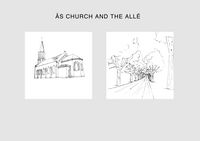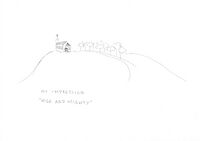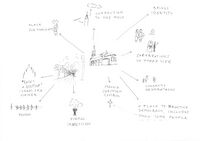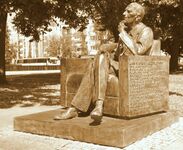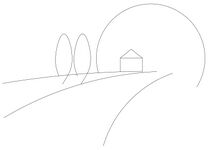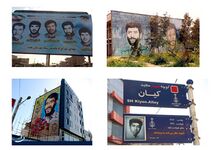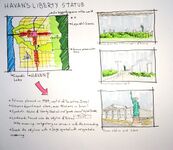LED Seminar 2016 - Landscape Symbols Reflection Group A
Landscape Symbol 1- Ås Church and Allee, Pirjetta Fagerli
Representations and analytical drawings
in addition to your initial visual please add two further analytical drawings of your symbol
Reflections
Placed on top of a high point in the landscape lies the church. A row of trees on both sides of the road makes it hard to miss. Allé brings rhythm to the landscape and leads the passersby towards the church. It can be seen as a symbol in the landscape, promising that something of great worth can be found at the end. As an arrangement, it is quite rigid and formal.
The church has great views due to the high location and looks mighty. Church as a symbol is at the same time static, meaning that it represents christianity and humans connection to God, but it has also changed throughout time and history. The church itself is still used in similar ways as before but maybe not as frequently. It is a historical symbol but also much more. It serves as a social meeting place and allows people to connect with their past while they are connecting with eachother. It can be seen as a center of the community and carries great identity on many levels of the society. It is also a sacred symbol and touches the lives of many throughout the celebrations of human life. It is still a strong christian symbol and might seem excluding to some groups, provoking to others.
Landscape Symbol 2- Bologna's Symbols, Benedetta Allegrini
Representations and analytical drawings
in addition to your initial visual please add two further analytical drawings of your symbol
- GroupI slide2.JPG
slide 2
- GroupI slide3.JPG
slide 3
Reflections
Please write a 250 words text reflecting on the following questions, you can also take ideas from your group members into account
- How and why did the symbols you identify appear in your landscape?
- Did their meaning change along with socio-political, economic, environmental or cultural changes in your region, or country?
- What do these symbols mean to you today? Are they meaningful to more than just one cultural group? Are they shared across cultures?
add your text here
Landscape Symbol 3-Bench of Jan Karski, Agnieszka Kudelka
Representations and analytical drawings
in addition to your initial visual please add two further analytical drawings of your symbol
- GroupI slide2.JPG
slide 2
- GroupI slide3.JPG
slide 3
Reflections
The monument is not very good visible in the landscape, but it's interesting and many people sit next to Karski to take a photo, and then get to know his history thanks to the text on the right site of the monument. I've got to know it by the visit in the Museum of the History of Polish Jews, which is next to the monument and I watch it always when I go there.
Its meaning didn't change along with socio-political, economic, environmental or cultural changes in my region and country because the socio-political, economic, environmental or cultural changes are not visible yet
This symbol is important for me because it's one of some "democratic monuments" in the city. It's a nice "human" monument. It's meaningful to more than just one cultural group: Poles, Jews, Germans and Americans, so it is shared across cultures.
Landscape Symbol 5- Schematic Symbol, Hani Gholami
Representations and analytical drawings
in addition to your initial visual please add two further analytical drawings of your symbol
- GroupI slide3.JPG
slide 3
Reflections
Please write a 250 words text reflecting on the following questions, you can also take ideas from your group members into account
- How and why did the symbols you identify appear in your landscape?
- Did their meaning change along with socio-political, economic, environmental or cultural changes in your region, or country?
- What do these symbols mean to you today? Are they meaningful to more than just one cultural group? Are they shared across cultures?
add your text here
Landscape Symbol 4- Araguaia Palace Palmas Brazil, Haroldo Pereira
Representations and analytical drawings
- GroupI slide2.JPG
slide 2
- GroupI slide3.JPG
slide 3
Reflections
Please write a 250 words text reflecting on the following questions, you can also take ideas from your group members into account
- How and why did the symbols you identify appear in your landscape?
- Did their meaning change along with socio-political, economic, environmental or cultural changes in your region, or country?
- What do these symbols mean to you today? Are they meaningful to more than just one cultural group? Are they shared across cultures?
The city of Palmas is the last planned capital in the XX century and was designed to be the capital of Tocantins, the newest state of Brazil. Palmas was designed between two landmarks, one natural (Carmo's Sierra) and the other artificial (Lajeado's Lake). The city has lots of other landmarks, such as the Girassol's Square (2nd biggest square in the world) and the Aragauaia Palace. The square is located in the meeting point of the two main axial avenues of Palmas. Havan is a brazilian department store and has over 90 stores in Brazil, including one in Palmas. The store has the replica of the Statue of Liberty as its symbol, and usually has a huge replica of it in front of the store. The biggest statue has 57 meters high, and it's the biggest statue in Brazil. In Palmas, the statue inserts itself in a strategic point turning itself into a landmark that has a huge impact in the landscape of the city and has no concern with the context, so it has no reason to be in such a strategic point. In some cities, the store was not allowed to put the statue. The facade is also a problem . One of the facades has a "classical" intention on it, and the other three are just blank walls. For some, the statue reinforces the lack of concern with the landscape of the city and the area in which the statue is inserted, and how a brand has the power to consolidate itself changing a whole skyline by just creating a visual focal point. But for others, the statue is a good thing, as it turned into a new " tourist attraction".
Group reflection
Please add a summary of your group reflection here
<gallery caption=" " widths="200px" heights="150px" perrow="3"> Image:last_slide.jpg|Group A
